#Gioacchino Colombo
Photo





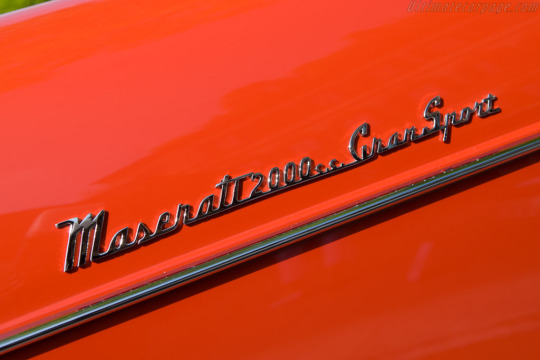

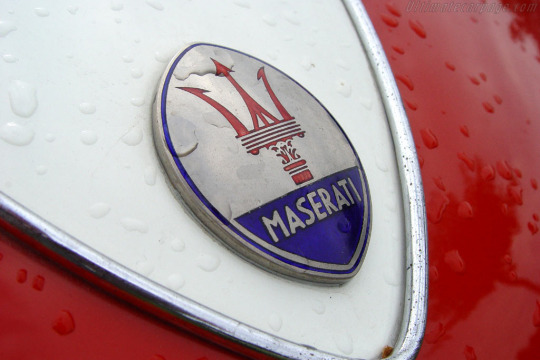
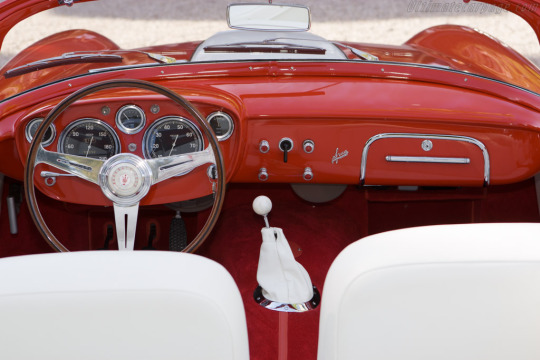

Maserati A6G/54 Spider by Frua (1 of 10).
From 1954 Maserati offered the final edition of the A6G sports car. As with its predecessor, the sales designation 2000 GT was frequently used in brochures and advertisements. On the race tracks of the World Sports Car Championship, the corresponding offshoots were called A6GCS. By 1957, only 60 Maserati A6G/54 cars had been built, with the bodies being exclusively built by external coachbuilders such as Allemano, Zagato and Frua.
So the A6G/54 presented at the Paris Motor Show in October 1954 had to meet high expectations. On the one hand, its driving performance was to clearly exceed that of its direct predecessor. On the other hand, Maserati naturally also wanted to increase its production figures again. And last but not least, there was direct competition with Ferrari, an up-and-coming company that had been enticing customers by building sports cars in the immediate vicinity since 1947. Accordingly, the engineers under Gioacchino Colombo began to thorougly rework the two-liter inline six-cylinder engine. Compared to the A6G, the ratio of bore to stroke was changed, turning a long stroke engine into a short stroke engine with two overhead camshafts. Compared to the A6GCS, Maserati used a chain instead of sprockets to drive the camshafts in the A6G/54 to improve reliability in everyday use. These measures increased the revs and thus the power output, which in this case was around 50 percent higher than that of the predecessor. Expressed in figures, 110 kW/150 hp was initially available, later even 118 kW/160 hp thanks to dual ignition.
As already mentioned at the beginning, Maserati at that time only produced the engines, transmissions and the tubular frame made of steel tubes including suspensions for the A6G/54. Then they sent the components to the coachbuilder selected by the individual customer. The official brochures offered a choice of four bodies. Tipo A and Tipo B came from Frua, Tipo C from Allemano and Tipo D from Zagato. Pinin Farina had previously fitted various A6 and A6G chassis, but then fell out of favour with Maserati when they entered into close cooperation with Ferrari. Only for the A6GCS, a few bodies were still being built there at the request of Maserati dealer Mimmo Dei.
This dealer was also the one who started the ball rolling for the A6G/54 Frua Spider. After a Spider based on a A6GCS chassis with the engine of the A6G/54 was completed in Pietro Frua’s workshop in the spring of 1955, Mimmo Dei ordered a small series of ten vehicles. However, only the first one was given the same design as the original model. The other nine were given an extended front and other modifications in detail. Different bumpers and small fake air intakes on the rear fenders for example.
65 notes
·
View notes
Text
Two Giants of Design
Two Giants of Design
It is August 1949 in Maranello. Most of Italy is on vacation, but not at Ferrari. Sitting here in the design office are the two most influential and talented designers of Ferrari’s early years: Aurelio Lampredi (left) and Gioacchino Colombo.
Colombo started at Alfa Romeo about a dozen years before the War and had a role assisting Vittorio Jano in the design of a number of Alfa Romeo engines in…
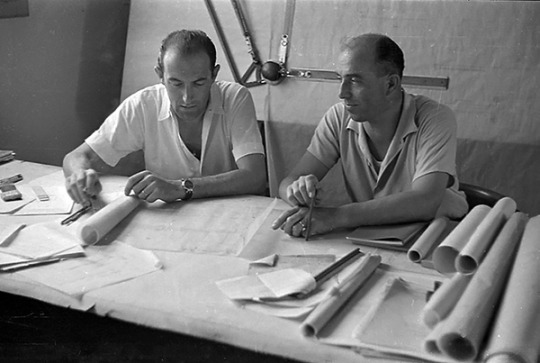
View On WordPress
1 note
·
View note
Text
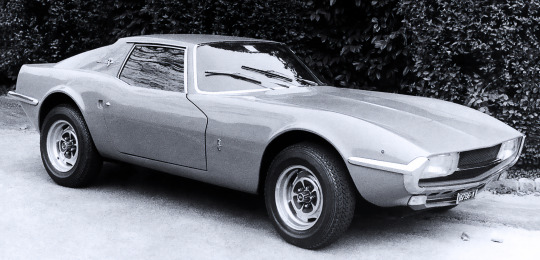


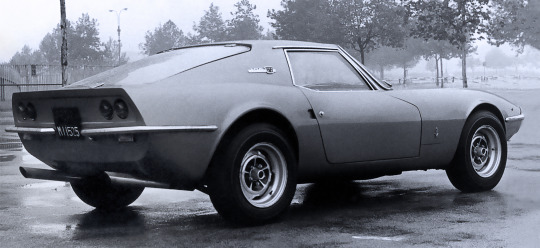

LMX Sirex 2300 HCS, 1969. Designed by Franco Scaglione with fibreglass bodywork by Eurostyle built on a chassis engineered by Gioacchino Colombo (the mastermind behind the Ferrari's V12). Some 42 cars were made between 1969 and 1974, all powered by Ford's 2.3 litre V6 with some later cars being turbocharged. The Hella headlamps came from a 1965 BMW 2000 while the taillights are off a Fiat 850 Spider (the prototype had twin round taillights).
232 notes
·
View notes
Text

Maserati 250F 2.5
Grand Prix racing wins
1954 Buenos Aires (Fangio)
1954 Spa (Fangio)
1956 Monaco (Moss)
1956 Monza (Moss)
1957 Buenos Aires (Fangio)
1957 Monaco (Fangio)
1957 Rouen (Fangio)
1957 Nurburgring (Fangio)
Forever associated with five-time Formula 1 World Champion, Juan Manuel Fangio, the Maserati 250F is the quintessential front-engined Grand Prix car. Designed principally by Gioacchino Colombo and Valerio Colotti, and introduced for the 1954 season, the 250F was constructed around a tubular ladder-frame chassis, with independent front suspension and a De Dion rear axle, and was powered by a 2½-litre double-overhead-camshaft straight-six engine.
Fangio secured two Grand Prix victories with the 250F before leaving for Mercedes-Benz, ending the '54 season as Formula 1 World Champion for the second time. Having secured a further two F1 World Championships, Fangio was back behind the wheel of a 250F, by this time further developed by Giulio Alfieri, for the 1957 season. Fangio drove to four more World Championship victories that year, including his legendary win at the Nürburgring where he overcame a 48-second deficit following a botched pit stop, passing race leader Mike Hawthorn on the penultimate lap. In doing so he broke the lap record ten times. Fangio's final win, this performance at the wheel of a Maserati 250F is often regarded as the greatest drive in Formula 1 history.
The late Sir Stirling Moss, who achieved his first Formula 1 victory at the wheel of a 250F when he won the non-Championship Oulton Park International Gold Cup in 1954, described the Maserati as "the most beautiful Formula 1 car in the world", an assessment few would disagree with.
#Maserati 250F 2.5#Maserati 250F#maserati#car#cars#racing#motor racing#f1#Grand Prix racing#grand prix#formula1#juan manuel fangio
26 notes
·
View notes
Text
Le grandi auto: Ferrari America
La lunga storia di una delle auto più singolari della Ferrari…
Da sempre Ferrari lega le sue auto alle qualità dei motori, come nel caso del 12 cilindri progettato da Gioacchino Colombo, presente nella 125 S di 1.500 cc, e in tutte le sue successive evoluzioni, con il tipo 166 portato a 2 litri e il Tipo 212 ri-configurato a 2.544 cc.
Continue reading Untitled
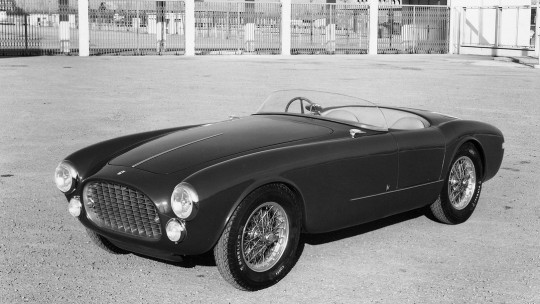
View On WordPress
0 notes
Text
El primer deportivo de Ferrari
A regañadientes, Enzo Ferrari comenzó a fabricar sus coches deportivos en 1947. El primero de ellos fue el 125 S, que estaba propulsado por un motor V12 de 1,5 litros, diseñado por Gioacchino Colombo. Con los ingresos de las ventas de sus Ferrari, el creador de la fábrica financiaba la participación en sus competiciones.

0 notes
Text
Il quarto gruppo di dieci titoli proposti dagli Amici della domenica per la LXXXVII edizione del Premio Strega:




▪ Marcello Fois, «La mia Babele» (Solferino), presentato da Elisabetta Mondello.
▪ Ermal Meta, «Domani e per sempre» (La Nave di Teseo), presentato da Furio Colombo.
▪ Giorgio Nisini, «Aurora» (HarperCollins), presentato da Massimo Onofri.
▪ Igiaba Scego, «Cassandra a Mogadiscio» (Bompiani), presentato da Jhumpa Lahiri.
▪ Andreea Simionel, «Male a est» (Italo Svevo), presentato da Gioacchino De Chirico.
▪ Simonetta Tassinari, «Donna Fortuna e i suoi amori» (Corbaccio), presentato da Marcello Rotili.
▪ Domenico Tomassetti, «Una vita come la tua» (Bertoni Editore), presentato da Giulio Marcon.
▪ Piero Trellini, «L’Affaire. Tutti gli uomini del caso Dreyfus» (Bompiani), presentato da Massimo Raffaeli.
▪ Valeria Tron, «L’equilibrio delle lucciole» (Salani), presentato da Vivian Lamarque.
▪ Francesca Veltri, «Malapace» (Miraggi Edizioni), presentato da Laura Massacra.
#PremioStrega2023
1 note
·
View note
Text
Ferrari 250 GT V12 Engine + Gearbox For Sale
Ferrari 250 GT V12 Engine + Gearbox For Sale
This Ferrari 250 GT V12 engine dates from the early 1960s, it was originally fitted to a Ferrari 250 GTE, but it was later fitted to a Ferrari 500 TRC in replacement of its original four-cylinder engine.
The Colombo V12
Ferrari’s Colombo V12 is one of the most famous engines in history, it was developed by Italian engineer Gioacchino Colombo for Enzo Ferrari in the late 1940s and it was…
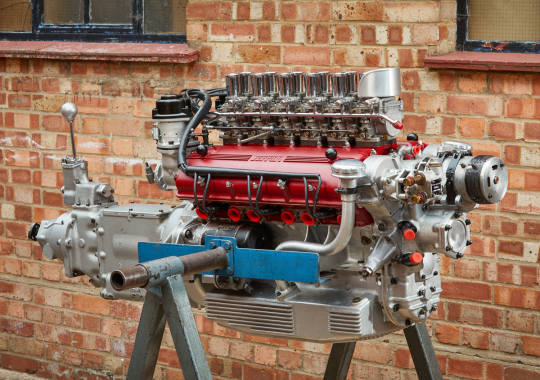
View On WordPress
0 notes
Photo

Ferrari 365 GT4 2+2 Berlinetta - 1975 by Perico001 Chassis n° 18537 Coachwork by Pininfarina Bonhams : The Autumn Sale 2020 Estimated : € 80.000 - 100.000 Unsold Autoworld www.autoworld.be Brussels - Belgium September 2020 "Most important was the double overhead cam engine. Like Rolls-Royce, no horsepower figure was quoted, but surely it was at least 320. More important was its massive amount of torque. Taken together with the turbine-like characteristics of the V12 engine, it mattered little which gear one was in or at what speed." – Stanley Nowak on the 356 GT4 2+2, Ferrari on the Road. By the mid-1960s, 50 percent of all Ferraris produced were being built with four seats, and the 365 GT4 2+2, introduced towards the end of 1972, was the biggest and best equipped of this family of four-seaters that had begun with the 250 GTE back in 1960. Flagship of the Maranello range, it reaffirmed Ferrari's determination to compete with the world's finest luxury saloons. Based on the preceding 365 GT 2+2, albeit lower, longer and wider, the newcomer was fitted with a four-cam version of the Gioacchino Colombo-designed 4.4-litre V12 engine while retaining its predecessor's mechanical underpinnings. Thus the '4' came with all-independent suspension featuring Koni's self-levelling system at the rear, while further refinements included mounting the engine and drive train in rubber bushes to insulate the car's occupants from noise and vibration, and offering air conditioning and ZF power-assisted steering as standard equipment. A total of only 524 of the luxurious Grandes Routières had been completed by the time production ceased in 1976. According to information supplied by Ferrari historian Marcel Massini, this beautifully presented 365 GT 2+2 was completed at Ferrari's Maranello factory in May 1975 and supplied via the official Ferrari dealer Crepaldi of Milan to its first owner. The original colour combination was Azzuro Hyperion (a light blue metallic) with Nero Cogolo leather interior, the same as now. The first owner was a Mrs Bruna Dondoni of Pavia in Northern Italy, who kept the car until 1982. The Ferrari was subsequently registered in Turin and more recently was owned by a resident of Pisa (from 2004 onwards). In 2014 the car passed into the hands of a well-known Italian nobleman in Tuscany (also the director of a bank) who owned it until 2019. The next owner commissioned a repaint in the original colour and at the same time the car received a through service at the Rome-based Ferrari dealer Samocar, for which invoices are available totalling almost €17,000. More recently the carburettors were cleaned, the air and oil filters changed, and the distributor caps and ignition leads renewed. Offered with Italian registration documents and the aforementioned invoices, this beautiful 365 GT 2+2 represents a wonderful opportunity to purchase a classic Ferrari combining the legendary carburettor-fed 12-cylinder engine and manual gearbox together with accommodation for four passengers in arguably one of the best colour combinations for the model. https://flic.kr/p/2jFGnbX
6 notes
·
View notes
Text

ASA (Autocostruzioni Società per Azioni) was an Italian automobile manufacturer active from 1961 to 1969, who is known for manufacturing the ASA 1000 GT. This car was developed by Ferrari engineers in the late 1950s as a less expensive, compact alternative to existing Ferrari GT cars. ASA used inline-four and straight-six engines derived from the "250" 3-litre V12 designed by Gioacchino Colombo. The chassis was developed Giotto Bizzarrini, and derived from the tubular frame of the 250 GTO.
103 notes
·
View notes
Photo

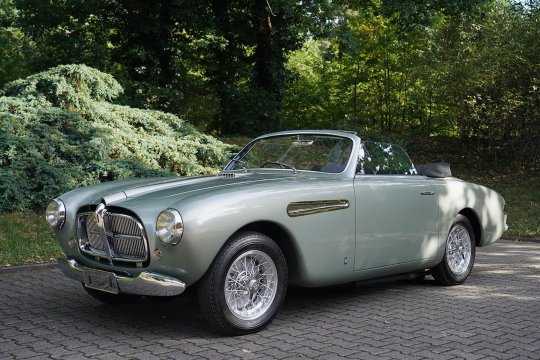
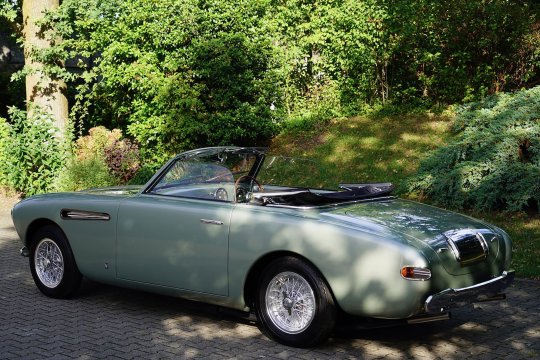
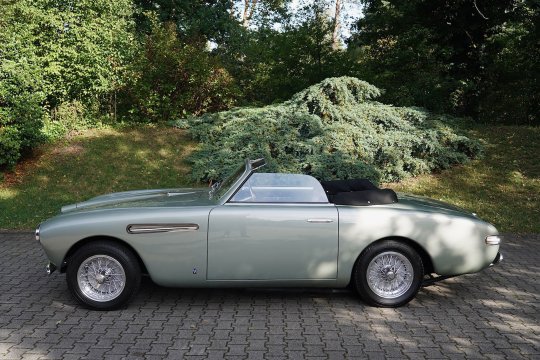






Ferrari 212 Inter Vignale Cabriolet
The Ferrari 212 Inter, has been considered the first successful model within the Ferrari produced in series, since it also did so with a wide variety of bodies: berlinetta, cabriolet and coupé. The 212 Inter incorporated bodies -it did not have a monocoque chassis-, from designers such as Ghia, Pininfarina, Stabilimenti Farina, Touring, Vignale and cabriolet versions from the British Abbott. It also marked the beginning of a long alliance between Ferrari and Pininfarina. On the outside, a long hood to shelter its V12, two large round headlights, its attractive chrome grille and an air intake next to the front fender stood out for any of its bodies. Its engine was the typical V12 of the house, the work of Gioacchino Colombo. With an inclination between benches of 60º and a diameter per stroke of 68×59 mm. It had a total displacement of 2.6 liters, had 24 valves in total and was placed in the longitudinal front position, just behind the front axle. The feeding was through a Weber 36 DCF double body carburettor, with the option of a kit of three carburettors for the most burned. The final power was between 130 and 150 CV at 6,500 revs for the configuration of a single carburetor, reaching 165 CV with the triple, being able to speed up the tachometer up to 6,900 revs in both cases.
Power was transmitted to the rear axle through a fully synchronized five-speed manual gearbox. As for its brake equipment, it mounted ancient and unsportsmanlike drum brakes on both axles inside some beautiful 15-inch-diameter spoked wheels and 175-millimeter-wide tires. The 212 Inter would be replaced just a year after its birth with fewer than 90 units built for the 250.
#Ferrari 212 Inter Vignale Cabriolet#Ghia#Pininfarina#Stabilimenti Farina#Touring#Vignale#Abbott#Gioacchino Colombo#250
108 notes
·
View notes
Text
Early Days in Maranello
Early Days in Maranello

In the Ferrari factory yard in Maranello on September 27, 1947 this new sports car is the final envelope body iteration of, we believe, chassis 01C, the very first Ferrari sports car. This latest body, showing its new hood scoop to feed the three centrally located Weber carburetors of its now 1.9 liter motor, was modified in house at Ferrari by Aristide Govoni who may well be sitting in the…
View On WordPress
0 notes
Photo
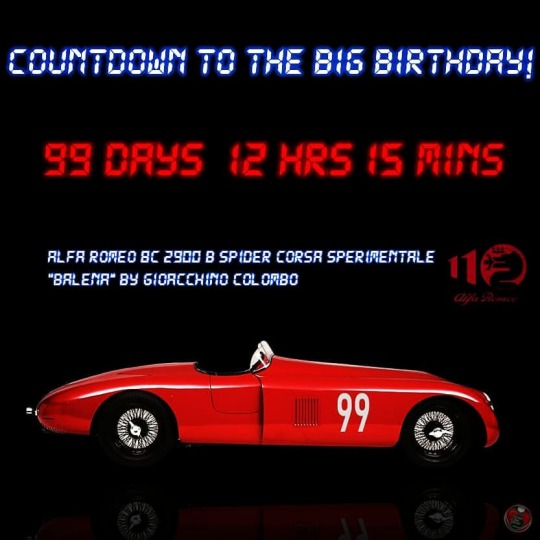
In 1941 Gioacchino Colombo, who was Vittorio Jano's apprentice, developed and also designed the engine, the fastest and strongest Alfa Romeo model before the war❗❤️🍀 https://www.instagram.com/p/B9gwZDAlihN/?igshid=1j5ew8yq5kmqy
7 notes
·
View notes
Text
F1 Dominators - Alfa Romeo 158/159 'Alfetta'
F1 Dominators – Alfa Romeo 158/159 ‘Alfetta’
The Alfa Romeo 158/159 Alfetta (Italian for ‘Little Alfa’) is considered to be one of the most successful racing cars of all time. The 158, and the succeeding 159, won 47 of the 54 Grand Prix entered between them. The Alfa Romeo 158/159 won 10 Formula One Grand Prix between 1950 and 1951 Image Source: Wikipedia The 158 was originally developed for the voiturette (French for ‘small car’) in 1937,…
View On WordPress
#Alfa Romeo#Antonio Labato#Dominators#F1#Formula One#Gioacchino Colombo#Giuseppe &039;Nino&039; Farina#Indianapolis 500#Juan Manuel Fangio#Luigi Fagioli#Marc Gené
0 notes
Photo
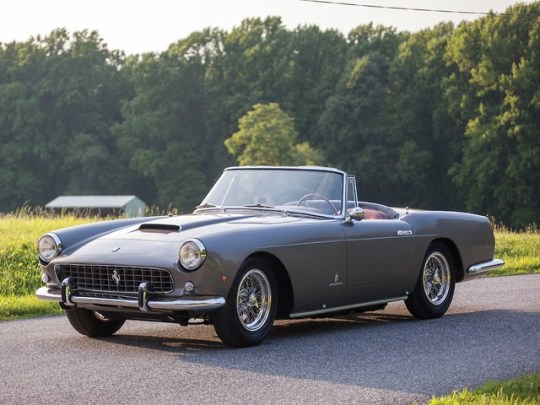
The Most Epic Car Masterpieces From The 60s
1960 Ferrari 250 PF Cabriolet
With the release of the Ferarri 250 PF Cabriolet in 1960, the luxury automaker continued its mission to offer something special to consumers that they couldn’t buy from another brand.
It served as the perfect car for touring and emerged as a car for those who wanted to go on a road trip. The 250 series cars are characterized by their use of 3.0 liters with a Colombo V12 engine, designed by Gioacchino Colombo. When the car was discontinued, the 275 and 330 series replaced it.
1 note
·
View note